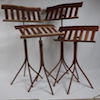So, the old problem of sliding and skating alignment when edge gluing to create a wider board..
I've done Advanced Search, and Googled, hoping for more ideas from Ya'll.
Need to make qty of 50 stain grade Pine shelves 16" x 96" x 3/4" each... using 3- "1x6" (S4S to 3/4") per shelf.
Yes, I am aware of factory made of the above from Big Box stores, want to use MY lumber.
Willing to make a dedicated glueup tabletop jigged for this if best ?
Regular Titebond 2.
I do have access to 26" wide belt, but rather not reduce panel thickness.
Would rather take more effort in alignment.
So, We know Biscuits, dowels, Domino, milled tongue/ groove etc edges, loose spline, keep clamps square, cauls,limiting end sliding, working on perfect flat table, making various purpose jigs, straightedge before walking away, etc.
I'll call those "Mechanical means".
Then, a bit different .. we have...Sprinkle sand, sprinkle Salt, (not gonna do that one), pin brads clip off head, stuff that increases friction to resist sliding.
Looking for more ideas that fit in the SECOND "friction" category, and any other tips.
Thank you, Marc




 Reply With Quote
Reply With Quote






